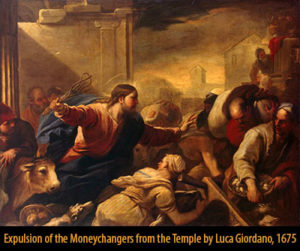On the following day, when they came from Bethany, he was hungry. And seeing in the distance a fig tree in leaf, he went to see if he could find anything on it. When he came to it, he found nothing but leaves, for it was not the season for figs. And he said to it, “May no one ever eat fruit from you again.” And his disciples heard it.
And they came to Jerusalem. And he entered the temple and began to drive out those who sold and those who bought in the temple, and he overturned the tables of the money-changers and the seats of those who sold pigeons. And he would not allow anyone to carry anything through the temple. And he was teaching them and saying to them, “Is it not written, ‘My house shall be called a house of prayer for all the nations’? But you have made it a den of robbers.” And the chief priests and the scribes heard it and were seeking a way to destroy him, for they feared him, because all the crowd was astonished at his teaching. And when evening came they went out of the city.
As they passed by in the morning, they saw the fig tree withered away to its roots. And Peter remembered and said to him, “Rabbi, look! The fig tree that you cursed has withered.” And Jesus answered them, “Have faith in God. Truly, I say to you, whoever says to this mountain, ‘Be taken up and thrown into the sea,’ and does not doubt in his heart, but believes that what he says will come to pass, it will be done for him. Therefore I tell you, whatever you ask in prayer, believe that you have received it, and it will be yours. And whenever you stand praying, forgive, if you have anything against anyone, so that your Father also who is in heaven may forgive you your trespasses.” –Mark 11:12-25
I watched the pilot episode of a new TV series last week. It’s about a low-level cabinet member who became President in an instant when the US Capitol Building was destroyed by terrorists during the State of the Union address. The digitally produced images of the ruins of the Capitol building were very realistic and gave me a terrible feeling. Could someone do that? Is this how it would be if they did? It was such a disturbing feeling that I wondered if the producers of the program had gone a little overboard. Then it hit me that this is akin to what the destruction of the Temple would have been like in Jerusalem. No one could have imagined such a sickening thought. Yet, in the passage above, Jesus is saying just that. Because of the corruption of the place, terrorists are going to come and “wither” it.
This passage is another great example of Mark’s use of “sandwich stories.” Vv. 12-14 are about the fig tree. Vv. 15-19 concern the Temple, and vv. 20-25 go back to the fig tree. The Temple portion is “sandwiched” in the before-and-after fig tree parts. Mark is using this literary device because we probably wouldn’t understand that the fig tree is a dramatic acted parable about what Jesus was going to do in the Temple.
Somewhere between Bethany and Jerusalem (not a long ways), Jesus comes upon a fig tree and curses it for not having figs even though it wasn’t the season for figs. Then Jesus goes into the Temple and, at least for a period of time, shuts down the operation of selling animals and money exchange services for the sacrifices people wished to present. What a scene! Jesus pronounces His verdict from Jeremiah: “Is it not written, ‘My house shall be called a house of prayer for all the nations? But you have made it a den of robbers.’” The first few chapters of Jeremiah make it clear that if Israel used the temple as an excuse for immoral behavior, then this wonderful blessing where heaven met earth would be judged.
Jesus says it has become “a den of robbers.” The word translated “robbers” or (some translations) “thieves” has a specialized flavor to it, meaning something more like “revolutionaries” or “insurrectionists.” Yes, they are thieves and robbers, but not generally so. They are the ultra-orthodox, planning and plotting. In other words, instead of becoming the light of the world to all the nations as the Temple was meant to be, these revolutionaries have a narrow, nationalist, political drive to bring a great rebellion against Rome. As we’ve seen before in Mark’s gospel, this is not Jesus’ way of bringing about the Kingdom of God.
The Temple will wither like the fig tree, but Jesus ends the section with a promise of hope. “Have faith in God. Truly, I say to you, whoever says to this mountain, ‘Be taken up and thrown into the sea,’ and does not doubt in his heart, but believes that what he says will come to pass, it will be done for him. Therefore I tell you, whatever you ask in prayer, believe that you have received it, and it will be yours.” The mountain that is “taken up and thrown into the sea” is the Temple Mount, and prayer is the cause of it. Just as Jesus cursed the fig tree, so the prayers of the saints are how God will deliver the Church. That’s why the persecuted saints must not become vindictive and unforgiving. “And whenever you stand praying, forgive, if you have anything against anyone, so that your Father also who is in heaven may forgive you your trespasses.” That’s how Jesus brings His great Kingdom, and that’s the gospel.
